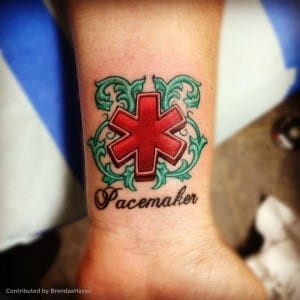
Dr. Bill Young

by Dan Limmer, BS, NRP
Our articles are read by an automated voice. We offer the option to listen to our articles as soon as they are published to enhance accessibility. Issues? Please let us know using the contact form.
We get quite a few questions that come in to us here at Limmer Education. Over the past year we have had several questions about using tattoos instead of medical alert devices. A quick search on the topic found that medical identification tattoos appear to be quite popular.
The question is whether they are as identifiable as a medical alert device.
In a July, 2014 USA Today article, Don Lundy from the National Association of EMTs says “We're not going to stop to read a tattoo in an emergency situation…" I disagree. It isn’t unusual for me to disagree with the NAEMT. And to be fair, they aren’t the only organization that has made a similar statement.
I disagree for a number of reasons. First, I think that tattoos are as easy to spot as a bracelet—especially when they are designed and applied properly. I also think there may be a generational issue at play. Tattoos seem to be more popular in younger generations. We old timers may just need to get with the game. Just because we wouldn’t think to tattoo the fact that we are a diabetic on our wrist doesn’t make it invalid.
Check out this Pinterest page for some good examples of tattoos I feel confident I would spot—and examples of tattoos that are ineffective because the art actually disguises the disease or condition.
If you are considering a tattoo as a medical alert device I would like you to consider the following:
Put it in a visible place. I believe the wrist is most visible—and a place we would look for medical identification devices. The torso is popular but may not be exposed in a medical patient. This means it may not be seen until the hospital—if at all.
The caveat to #1 is that everyone will see it. You can never take it off.
Don’t let the art overshadow the message. One of the big complaints about medical identification bracelets is that they aren’t really stylish. Tattoos will likely have the same issue.
Some sources say it may not be identifiable as medical identification, yet they acknowledge that it is better than nothing at all.
Make sure your medical condition doesn’t prohibit tattoos (e.g. because of bleeding or infection that may result).

Contributed by BrendaaHayes
If you are an EMS provider reading this I have one piece of advice for you: Consider tattoos when you are looking for medical identification “devices.” They are out there—and some are very cool.

Dr. Bill Young

Limmer Education

Limmer Education
Glad I found this discussion. I have a metal stiffening ring implanted in my mitral valve and was concerned that an MRI or other procedure could affect the implant. I was therefore tattooed (right buttock) with all the pertinent information, including model and serial number of the implanted ring. The tattoo is the size of an index card. Since it is hidden from normal view, it does not affect my daily life. I notify medical personnel of the tattoo prior to any medical procedure.
I've been having this discussion a lot lately. I've been looking to get a tattoo for my type 2.. My psychiatrist told me that even hospitals around us are recognizing these tattoos as medic alerts now. And yes to do the inside wrist, but not just for ease of seeing the tattoo, but because if the go to do an IV then that's what they see!!! Very good advice!
I was blessed over the Spring Break to volunteer at Camp Vegas, a one week camp for kids with Type One DM. I was kind of surprised at the number of kids (one who was 12) who had tattoos identifying them as Type One Diabetics. The tattoos were well done, well placed and easy to read.
I agree with you about this being a generational thing and that makes it important for us to consider in the field.
Thanks for a great post! Be safe out there sportsfans!
Thanks Kenny for commenting and sharing your experience! A 12 yo with a medical id tattoo? I wonder how many of us would think to look for such a tattoo on someone so young? A great heads up for all providers out there!